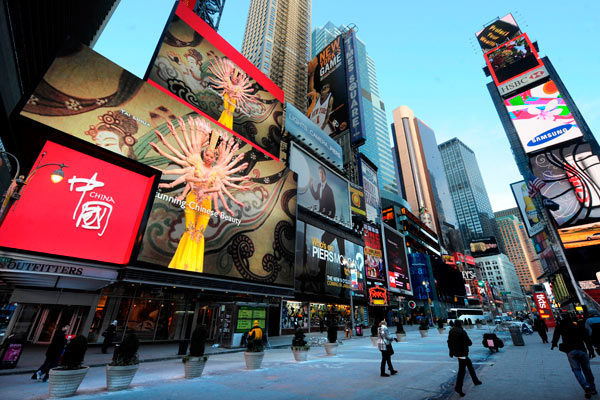Experts: National branding necessitates personal finesse

At Times Square, New York, a giant digital screen broadcasts a publicity video intended to promote China's national image.
The ninth International Conference of Chinese Media and Civilization was held in Wuhan on Aug. 20. This year’s conference focused on national branding.
A country’s national image is the sum total of foreign perceptions of its general characteristics. “Popular opinion is the determining factor in global evaluation of a certain country,” said Zhang Kun, dean of the School of Journalism and Information Communication at Huazhong University of Science and Technology.
The public generally considers the government to be solely responsible for national branding and publicity, so they tend to see its grand projects as having little impact on their daily lives, Zhang said.
However, as the frequency of people-to-people exchanges grows, China’s national image becomes increasingly contingent upon the words and deeds of its citizens at home or abroad, said Cheng Manli, president of the National Institute of Strategic Communication at Peking University. “Citizens amount to a nation’s name card,” Cheng said, adding that compared with media propaganda, interpersonal interaction plays a more decisive role in shaping a country’s national image.
That is why national branding requires public engagement in addition to government planning, Zhang said. To further the cause, official propaganda needs to be combined with people-to-people communications and media. Confucius Institutes and various cultural organizations should play a bigger role, he said.
National branding is a dynamic process. As China’s influence in the international arena grows, reframing and renewal of the national image becomes essential, said Cheng. She said China’ new image should be an organic mixture of its ancient glories, modern achievements and future potential.
“In an era of globalization, authenticity, change and hope should be the keywords of China’s new image,” Zhang said. At the same time, cultural differences and divergence of core values often impede cross-civilizational exchange and lead to misunderstandings. “That is why national branding needs to be approached from an intercultural perspective that highlights an empathetic understanding of cultural differences, a genuine respect of the uniqueness of each civilization and a concerted effort to dismantle the barriers to cross-civilizational exchange,” he said.
“A specialized nation-branding campaign is the way to go,” Cheng said. She said government should put together its best resources to enhance China’s discursive power and to build a dozen flagships of outbound communication. In addition, Chinese media practitioners need to think about how to spread and rebroadcast China’s message through mainstream press and TV networks in the West.
Ming Haiying is a reporter at the Chinese Social Sciences Today.
